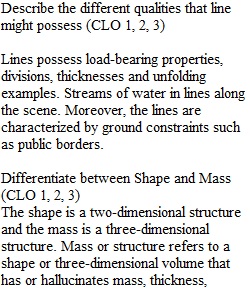


Q Introduction Understanding a work of art really means thinking about the artist's choices. Everything in a work of art, the artist has either put there, or allowed it to remain. An artwork is really just a big pile of choices to think about. Each choice is an expression. Why this kind of line, or that kind of shape, or this color rather than a different line, shape or color, or even none at all? How we interpret, think and feel about a work is based on the total effect of these choices. The first set of choices to think about are the Visual Elements. Like the individual words in a paragraph or tones in a song, visual elements don't convey the whole experience on their own, but they are a vital part to building it. When thinking about a work of art, looking at each visual element and how it is used or not used as well as what it conveys tells us a little bit about what's going on. Unit Learning Outcomes • Describe the different qualities that line might possess (CLO 1, 2, 3) • Differentiate between Shape and Mass (CLO 1, 2, 3) • Describe the ways in which artists use light to represent space and model form. (CLO 1, 2, 3) • Explain how color might be used both in representational painting and as a symbolic tool. (CLO 1, 2, 3) • Outline some of the ways in which time and motion inform our experience of visual art. (CLO 1, 2, 3) Directions 1. Take a look at the image of the painting Napoleon Leading the Army over the Alps by Kehinde Wiley (2005).Download Napoleon Leading the Army over the Alps by Kehinde Wiley (2005). 2. Review your reading and/or the videos about artistic elements. 3. Write a paragraph for each item on the list below explaining how each artistic element is used in the artwork. (150 to 300 words for each item in the list.) 4. Submit the written response as a Word or PDF document named: Assignment2.lastname.doc. Using the terms you’ve learned, describe how this artist uses the following art elements within this work. Write 150 to 300 words per list item below. (600 to 1200 words total.) • o line o shape and space o light and color o texture time and motion Due Date • Submit by 11:59p.m., Sunday, CT. Rubric Unit 2: Evaluation - Art Elements Unit 2: Evaluation - Art Elements Criteria Ratings Pts This criterion is linked to a Learning OutcomeLevel of Understanding - Line 10 pts Excellent Demonstrates an exceptional understanding of the element or design principle discussed, and how it applies to the work in question. 9 pts Proficient Demonstrates a clear and complete understanding of the element or design principle discussed, and how it applies to the work in question. 7 pts Sufficient Demonstrates a moderate level of understanding of the artistic element or design principle discussed and how it applies to the work in question. 6 pts Developing Demonstrates some degree of understanding of the artistic element or design principle discussed and how it applies to the work in question, but often struggles. 5 pts Needs Improvement Demonstrates little to no understanding of element or principle of design discussed or how it applies the work in question 10 pts This criterion is linked to a Learning OutcomeLevel of Understanding – Shape and Space 10 pts Excellent Demonstrates an exceptional understanding of the element or design principle discussed, and how it applies to the work in question. 9 pts Proficient Demonstrates a clear and complete understanding of the element or design principle discussed, and how it applies to the work in question. 7 pts Sufficient Demonstrates a moderate level of understanding of the artistic element or design principle discussed and how it applies to the work in question. 6 pts Developing Demonstrates some degree of understanding of the artistic element or design principle discussed and how it applies to the work in question, but often struggles. 5 pts Needs Improvement Demonstrates little to no understanding of element or principle of design discussed or how it applies the work in question. 10 pts This criterion is linked to a Learning OutcomeLevel of Understanding – Light and Color 10 pts Excellent Demonstrates an exceptional understanding of the element or design principle discussed, and how it applies to the work in question. 9 pts Proficient Demonstrates a clear and complete understanding of the element or design principle discussed, and how it applies to the work in question. 7 pts Sufficent Demonstrates a moderate level of understanding of the artistic element or design principle discussed and how it applies to the work in question. 6 pts Developing Demonstrates some degree of understanding of the artistic element or design principle discussed and how it applies to the work in question, but often struggles. 5 pts Needs Improvement Demonstrates little to no understanding of element or principle of design discussed or how it applies the work in question. 10 pts This criterion is linked to a Learning OutcomeLevel of Understanding – Texture, Time and Motion 10 pts Excellent Demonstrates an exceptional understanding of the element or design principle discussed, and how it applies to the work in question. 9 pts Proficient Demonstrates a clear and complete understanding of the element or design principle discussed, and how it applies to the work in question. 7 pts Sufficient Demonstrates a moderate level of understanding of the artistic element or design principle discussed and how it applies to the work in question. 6 pts Developing Demonstrates some degree of understanding of the artistic element or design principle discussed and how it applies to the work in question, but often struggles. 5 pts Needs Improvement Demonstrates little to no understanding of element or principle of design discussed or how it applies the work in question. 10 pts Total Points: 40 PreviousNext
View Related Questions